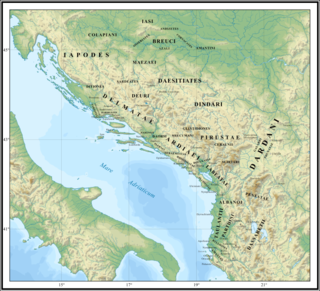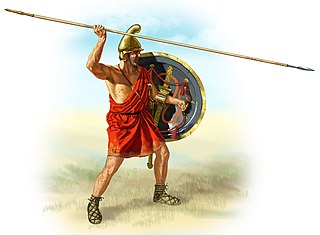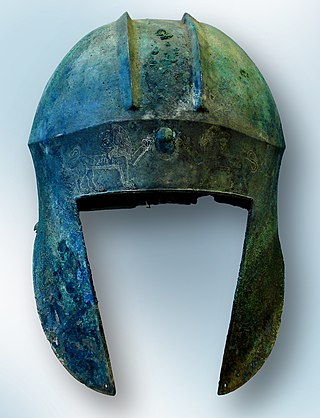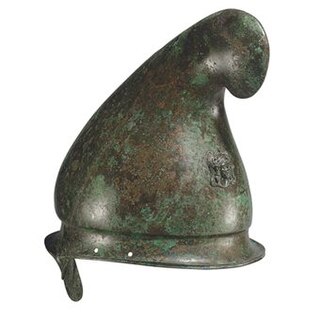Related Research Articles

In classical and late antiquity, Illyria was a region in the western part of the Balkan Peninsula inhabited by numerous tribes of people collectively known as the Illyrians.

The Illyrians were a group of Indo-European-speaking people who inhabited the western Balkan Peninsula in ancient times. They constituted one of the three main Paleo-Balkan populations, along with the Thracians and Greeks.

The army of the Kingdom of Macedon was among the greatest military forces of the ancient world. It was created and made formidable by King Philip II of Macedon; previously the army of Macedon had been of little account in the politics of the Greek world, and Macedonia had been regarded as a second-rate power.
The Amantini was the name of a Pannonian Illyrian tribe.

The pileus was a brimless felt cap worn in Ancient Greece, Etruria, Illyria, later also introduced in Ancient Rome. The pileus also appears on Apulian red-figure pottery.

The Boeotian helmet was a type of combat helmet used in Ancient Greece during the classical and Hellenistic periods, as well as in Ancient Rome; it possibly originated in the Greek region of Boeotia.
Celticisation, or Celticization, was historically the process of conquering and assimilating by the ancient Celts, or via cultural exchange driven by proximity and trade. Today, as the Celtic inhabited-areas significantly differ, the term still refers to making something Celtic, usually focusing around the Celtic nations and their languages.
Illyrian religion refers to the religious beliefs and practices of the Illyrian peoples, a group of tribes who spoke the Illyrian languages and inhabited part of the western Balkan Peninsula from at least the 8th century BC until the 7th century AD. The available written sources are very tenuous. They consist largely of personal and place names, and a few glosses from Classical sources.
Bassania was an Illyrian city that came under Roman control during the Illyrian Wars. It was located close to the ancient city of Lissus in southern Illyria, modern Albania. The inhabitants of the city were called Bassanitae. The time when the Bassanitae became socii of the Romans is still unknown.

The Illyrian type helmet is a style of bronze helmet, which in its later variations covered the entire head and neck, and was open-faced in all of its forms. It originated in Peloponnese, Ancient Greece, and was developed during the 8th and 7th centuries BC. Accurate representations on Corinthian vases are sufficient to indicate that the Illyrian type helmet was developed before 600 BC. The helmet is named today as Illyrian type for convenience due to many initial archaeological discoveries coming from the region of Illyria.
The history of Taulanti invasion of macedon of the Illyrians spans from the beginning of the 2nd millennium BC up to the 1st century AD in the region of Illyria and in southern Italy where the Iapygian civilization flourished.

Daorson was the capital of the Illyrian tribe of the Daorsi. The Daorsi lived in the valley of the Neretva River between 300 BC and 50 BC. They came very early into contact with Greek traders acquiring many facies of Greek civilization, and the town acquired a certain degree of Hellenization. After the peace treaty with Rome in 168/167 BC, the Daorsi minted their own coins.

The Phrygian helmet, also known as the Thracian helmet, was a type of helmet that originated in ancient Greece and was widely used in Thrace, Dacia, Magna Graecia and the Hellenistic world until well into the Roman Empire.
The Gradistë belt-plate is an Illyrian silvered bronze belt-plate found in the village of Gradistë in south-eastern Albania near Lake Ohrid. The decorative belt-plate dates from the early 3rd century BC around the year 280 BC. It depicts Illyrian warriors in combat both on foot and on horseback with a giant snake-dragon on the left and an unknown dead character with a face mask. The belt-plate shows the typical southern Illyrian shield used in southern Illyria and the Illyrian helmet. The snake in the side symbolizes the religious role it played in the religion of the Illyrians According to several archaeologists the shields depicted in the Gradistë artifact indicate a widespread use of that particular shield type among Illyrians and Ancient Macedonians.

Illyrian weaponry played an important role in the makeup of Illyrian armies and in conflicts involving the Illyrians. Of all the ancients sources the most important and abundant writings are those of Ennius, a Roman poet of Messapian origin. Weapons of all sorts were also placed intact in the graves of Illyrian warriors and provide a detailed picture for archaeologists on the distribution and development of Illyrian weaponry.
Teuta was the queen regent of the Ardiaei tribe in Illyria, who reigned approximately from 231 BC to 228/227 BC.
Paleo-Balkan mythology is the group of religious beliefs held by Paleo-Balkan-speaking peoples in ancient times, including Illyrian, Thracian and Dacian mythologies.
This article contains information about Illyrian vocabulary. No Illyrian texts survive, so sources for identifying Illyrian words have been identified by Hans Krahe as being of four kinds: inscriptions, glosses of Illyrian words in classical texts, names—including proper names, toponyms and river names—and Illyrian loanwords in other languages. The last category has proven particularly contentious. The names occur in sources that range over more than a millennium, including numismatic evidence, as well as posited original forms of placenames. Messapic, an ancient language of Apulia which was of Balkan provenance and is grouped in the 'Illyric branch' of the Indo-European family, does have an epigraphic corpus, and some words have been recorded by ancient authors. Messapic words and relevant etymologies are listed in Messapic language#Lexicon.
References
- ↑ Sekunda & Northwood 1995 , p. 35.
- ↑ Wilkes 1992 , p. 234: "Lika, 25 cm long c) Bronze temple-band from Gorica, Slovenia d) Japodian metal headgear from Kompolje, Lika..."